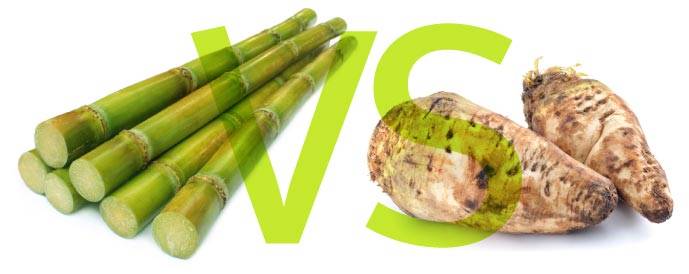Reliable Cane Sugar Processing: Optimizing Return and Pureness
Reliable Cane Sugar Processing: Optimizing Return and Pureness
Blog Article
A Comprehensive Overview to the Environmental Effect and Sustainability Practices in Walking Cane Sugar Handling
The ecological effect of walking stick sugar processing offers an intricate variety of challenges that warrant careful exam. From soil degradation and excessive water use to the carbon impact associated with farming and production, the effects of traditional techniques are far-reaching. What specific methods can be executed to strike a balance in between performance and ecological stewardship?
Overview of Walking Cane Sugar Processing
Walking cane sugar processing entails a series of systematic actions that transform sugarcane into refined sugar. Initially, gathered sugarcane is transported to processing facilities, where it undergoes cleansing to remove soil and debris. Following this, the walking stick is squashed to remove juice, which is then cleared up by eliminating contaminations with heating and the enhancement of lime.
The made clear juice undergoes evaporation, where water is eliminated to focus the sugar content. These crystals are divided from the staying syrup utilizing centrifugation, resulting in raw sugar.
The final product is after that dried and packaged for distribution. Throughout this whole process, keeping performance and top quality control is necessary to ensure the sugar satisfies industry standards. Each step in walking stick sugar processing not only adds to the end product yet additionally has effects for source use and waste generation, setting the stage for conversations on sustainability and environmental influences related to sugar production.
Ecological Obstacles of Manufacturing
The production of walking cane sugar offers several considerable environmental difficulties that warrant interest. One key concern is the substantial use agrochemicals, consisting of plant foods and pesticides, which can result in soil degradation, biodiversity loss, and contamination of neighborhood water sources. The runoff from sugarcane fields frequently carries these chemicals right into neighboring environments, interfering with aquatic life and influencing the wellness of neighborhoods reliant on these water bodies.
An additional obstacle is the high power consumption connected with sugarcane processing. The boiling and refining stages call for significant warm, mainly produced by burning fossil fuels, adding to greenhouse gas exhausts. Furthermore, the expansive acreage required for sugarcane growing can cause logging and habitat devastation, further worsening climate adjustment and threatening wildlife.
Moreover, the labor techniques in some areas elevate moral issues, as workers may encounter bad working problems and poor salaries. This situation usually perpetuates a cycle of poverty in local communities. Cane Sugar Processing. Attending to these environmental difficulties is crucial for creating more lasting techniques in walking stick sugar manufacturing, ultimately benefiting both the atmosphere and the communities included in this sector
Water and Land Use Effect
Water sources and land utilization are vital parts in the cane sugar market that significantly affect the setting. The growing of sugarcane requires substantial water input, with quotes suggesting that it can take in up to 2,000 liters of water per kg of sugar generated. This intensive use of water frequently brings about depletion of regional water sources, influencing not just the sugarcane plantations however also bordering ecological communities and neighborhoods that rely upon the same water resources for farming and residential usage.

Additionally, land usage for sugarcane cultivation can cause logging and the conversion of natural environments right into monoculture haciendas. This method diminishes biodiversity, interrupts neighborhood environments, and adds to soil deterioration. The expansion of sugarcane fields usually intrudes on beneficial agricultural land, producing competitors for resources between food and biofuel manufacturing.
Lasting techniques, such as enhancing watering techniques and executing plant turning, are important to alleviate these influences. By adopting much more reliable water usage and land management techniques, the walking cane sugar sector can reduce its ecological footprint, making sure an equilibrium in between farming productivity and environmental preservation.
Greenhouse Gas Emissions
Greenhouse gas discharges stand for a substantial ecological concern within the cane sugar processing industry, particularly as agricultural practices increase to meet global demand. The cultivation of sugarcane, a crop that flourishes in tropical environments, counts greatly on artificial plant foods and chemicals, which add to laughing gas exhausts. Additionally, land-use adjustments, including deforestation for brand-new sugarcane plantations, launch co2 saved in plants and soil.
Throughout processing, energy intake is an additional major source of greenhouse gas exhausts - Cane Sugar Processing. Lots of sugar mills utilize nonrenewable fuel sources to power machinery and generate warmth, leading to considerable carbon impacts. Moreover, the transportation of raw sugarcane and ended up items adds layers of exhausts with gas burning in vehicles
The collective impact of these emissions aggravates climate adjustment, presenting risks not just to the environment yet also to the lasting practicality of learn the facts here now the industry. Stakeholders have to acknowledge get redirected here the immediate requirement for thorough techniques that address these discharges. This entails reviewing current farming practices, processing techniques, and transport systems to determine locations for enhancement and reduction. Attending to greenhouse gas emissions is crucial for promoting an extra sustainable walking cane sugar industry in an altering climate.

Sustainable Practices and Innovations
Lasting techniques and technologies are significantly crucial in the cane sugar handling industry as stakeholders look for to decrease ecological effects while keeping efficiency. One substantial improvement is the execution of integrated plant management, which enhances resource usage by combining soil monitoring, insect control, and plant rotation methods. This strategy improves return while minimizing chemical inputs and protecting dirt health.
In addition, the fostering of renewable resource resources, such as biomass from sugarcane deposits, has gotten grip - Cane Sugar Processing. By converting waste products right into power, processing facilities can minimize their dependence on fossil fuels, consequently reducing greenhouse gas exhausts
Water management methods have actually additionally seen improvements with the recycling and reusing of water in handling plants, significantly decreasing freshwater usage. Advancements in innovation, such as accuracy farming, make it possible for farmers to keep track of crop health and wellness and source use better, guaranteeing sustainable growing methods.
Additionally, accreditation programs like Fair Trade and Jungle Partnership motivate ecologically accountable farming techniques and advertise social equity within the supply chain. By welcoming these lasting methods and advancements, the walking cane sugar handling market can improve its durability and contribute positively to environmental stewardship.
Conclusion
The environmental impact of cane sugar processing presents substantial obstacles, consisting of dirt deterioration, high water usage, and greenhouse gas Read Full Article emissions, alongside moral problems connected to labor methods. Attending to these problems through lasting techniques, such as incorporated crop management, eco-friendly power adoption, and water recycling, is vital. By promoting socially equitable and environmentally liable techniques in sugar production, the industry can alleviate its negative impacts, ensuring an extra lasting future for both communities and neighborhoods associated with this sector.
Walking cane sugar processing involves a collection of systematic actions that transform sugarcane into polished sugar. Each step in walking cane sugar processing not just contributes to the last product yet likewise has implications for source use and waste generation, establishing the stage for conversations on sustainability and ecological effects associated with sugar manufacturing.
Greenhouse gas emissions stand for a significant environmental concern within the walking cane sugar processing market, specifically as agricultural techniques expand to fulfill global demand.Lasting practices and technologies are progressively essential in the cane sugar handling sector as stakeholders seek to lower environmental effects while keeping productivity.The environmental effect of walking cane sugar processing provides substantial challenges, including dirt destruction, high water consumption, and greenhouse gas discharges, along with ethical issues associated to labor techniques.
Report this page